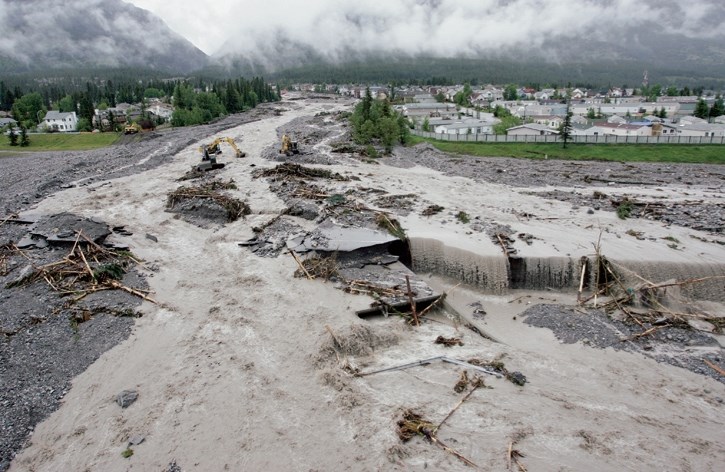BANFF – Banff and Canmore are working on a regional management plan to help guide how the two communities would respond together during significant emergencies and disasters.
Officials say climate change has played a role in the frequency and severity of major emergencies, noting the intent of regional management is to increase capacity, preparedness, and resilience in the face of a disaster affecting the Bow Valley.
“Major emergencies and disasters are becoming more and more frequent and longer durations,” said Silvio Adamo, fire chief and director of protective services for the Town of Banff during a Dec. 12 council meeting.
“The main intent of this is to really create capacity within emergency management to work in a much more collaborative manner so that we’re not operating in our own silos,” he added.
“Working on the same platform and being familiar with processes and capacities would certainly lead to more efficient and effective and quicker responses, to be quite frank.”
Due to an increase in complex emergencies and disasters, the Alberta government introduced several changes to the emergency preparedness system to improve public safety governance and provided grants to communities looking to work together.
In 2019, both Banff and Canmore councils passed resolutions to apply for the provincial grant to create a regional emergency management plan. They were successful in getting $170,000 in early 2020, but work was delayed due to the COVID-19 pandemic.
Work is well underway this year with a hired consultant, Response Team Inc., with development of a regional emergency response bylaw and completion of a regional hazard identification and risk assessment expected by June 2023.
There is also a plan to develop a Bow Valley regional emergency management agency and advisory committee, and evaluation of the new regional emergency management plan though a tabletop exercise, perhaps as early as May.
“I appreciate how this is going to increase the safety of our valley,” said Banff Coun. Chip Olver.
Caitlin Miller, manager of protective services and director of emergency management for Town of Canmore, said the The Town of Canmore declared a climate emergency in October 2019 and addressing climate adaptation and community resiliency in the face of climate-related hazards and emergencies continues to be a priority for council and the community.
"The purpose of a regional emergency management plan is to continuously progress towards a higher level of preparedness and response capability, to better protect the the public and stabilize compelx emergencies or diasters faster," she said during a Canmore committee of the whole meeting on Dec. 20.
Adamo said he believes the communities of Banff and Canmore could have managed the 2013 foods in a more collaborative manner had a more formal regional approach been in place, such as sharing of human and operational resources and a unified voice to the province of Alberta.
“Canmore, yes, was impacted more and so maybe Banff was in more support in Canmore as opposed to them struggling on their own to maintain their emergency coordination centre and all the objectives they had going on,” he said.
“That’s a simple example of why we believe regional collaboration is the right way to go with emergency management. It establishes not only that capacity but a formal process so that we’re not scrambling in the event of a significant emergency that impacts both communities.”
Adamo said the regional emergency approach will formalize unified command and emergency coordination centres during a disaster and ensure regional roles and responsibilities are developed and understood ahead of time.
In addition, he said a regional program means there would be less confusion around authorities and jurisdiction during an emergency response, as well as the potential for costly duplication or competition for resources.
But Adamo said a regional emergency management approach does not mean normal day-to-day operations of emergency services or small-scale municipal emergency management would be regionalized.
Instead, he said it would provide thresholds for promptly activating a regional emergency coordination centre in response to emergencies or disasters that could overwhelm the resources of either municipality.
For example, he said a flood or wildfire threatening Banff or Canmore may result in evacuations of portions or an entire community of either town, and may render the emergency coordination centre unusable, as occurred during the 2011 Slave Lake wildfire that forced mass evacuations and destroyed about 350 properties.
“I want to be clear on this … this is simply a framework and plan for the really, really significant large impact emergencies that affect both communities,” he said.
“We will still maintain our municipal emergency plans. We will still do municipal emergency management at that level, so this isn’t taking over any of the functions that we currently do.”
Neighbouring communities such as the MD of Bighorn, Kananaskis Improvement District, and Stoney Nakoda First Nation, which are aware of this project, can be invited into the regional plan once it is established.
A recommendation for a jointly funded regional emergency management coordinator position will be presented to both Banff and Canmore councils to consider after the regional plan is implemented, and when both municipalities have had a chance to evaluate the capacity of both directors of emergency management to maintain the program.
“That would be down the road,” Adamo said, noting it would be unlikely to happen before 2024 or 2025.




